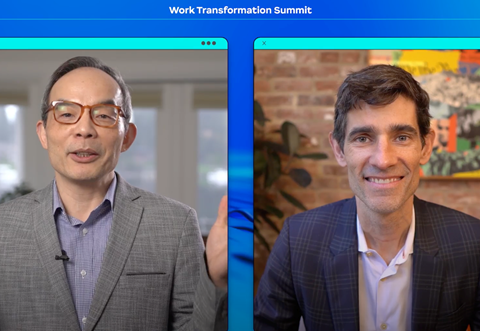Here’s the interview snippet from the interaction with Mr. Anand Bala SMB Lead, India and SAARC
Khushagra: What will be Zoom’s relevance in the hybrid future across healthcare, BFSI, government sectors?
Anand: As we look ahead, we know the future is about freedom of choice. We are seeing many companies choosing to continue with hybrid forms of work as the pandemic has revealed that hybrid work can result in better work-life balance and an equally or even more productive workforce. Supporting a hybrid office environment with both in-office and remote workers will be critical to the success of organisations around the world as they return to the office. We are committed to supporting businesses in getting the most out of their workspaces, irrespective of where their employees choose to work. Beyond workplace transformation, Zoom is also reimagining the use of virtual collaboration across industries like banking, healthcare, education, events, and even government services.
Virtual visits through video collaboration platforms have become a staple of healthcare delivery, enabling improved access to care with efficient use of resources. Zoom as a virtual collaboration platform can support both business and clinical operations, streamlining connections between providers, staff, patients, family members, and administrators. Banking and financial institutions are leveraging Zoom for streamlining the recruitment process, accessing diverse talent, more efficiently building teams and better supporting their growing customer base. Zoom has also been working with various branches of the government in India – both central and state. Various state government and political leaders have been using Zoom for uninterrupted and safe collaboration. We are inspired not only to adapt to a new normal but to anticipate what comes next and come up with total platform solutions to address it.
Khushagra: How is Zoom enabling small and medium enterprises?
Anand: Zoom serves organizations of all industries and sizes because our platform can flexibly scale to fit any user count and budget. But one of the exciting things is seeing just how much of an impact Zoom can have on small businesses.
Small and medium enterprises (SMEs) face challenges that are unique to their business operations — executing multiple processes with just a few people and limited budget while simultaneously prioritizing time and resources to make it all happen efficiently. All this and more can be solved with the Zoom platform. Zoom provides easy-to-use video communications that empower people to accomplish more.
Virtual collaboration can provide SMEs the support they need to scale sustainably and grow their presence locally and beyond. Zoom’s simplicity and ease of use, not to mention its tiered pricing and usage plans, simplify how small-business teams manage their time, enhance productivity, and scale the company. The Zoom platform provides leading collaboration services for every small business looking to become the next large enterprise.
Olive Living, a next-gen living community in India, found the perfect solution with Zoom Rooms Virtual Receptionist which is being leveraged at some of their properties to greet guests upon arrival, provide seamless check-in, and receive feedback on their virtual receptionist experience. Cypeer brings cybersecurity peers around the world to meet, share, learn, and make connections. The company is rolling out their platform with the integration of Zoom Meetings SDK to enable seamless collaboration while bringing together people for live interactions. BrightCHAMPs, a leading EdTech company, is leveraging Zoom to offer 1:1 technology classes for kids.
Khushagra: Can you highlight the importance of the SME segment for Zoom? What is Zoom’s go-to-market strategy for SMEs?
Anand: India has more than 7.9 million micro, small, and medium enterprises (MSMEs), as of 27 March, 2022, according to the Ministry of Micro, Small, & Medium Enterprises. The sector has contributed greatly to employment generation, innovation, and inclusive growth of the economy. In India, SMEs form the backbone of socio-economic development and are the engines of growth and innovation in the region. Zoom’s SME segment continues to grow as more and more SMEs onboard digitalisation.
The SMB segment is not immune to the current economic headwinds. We are also witnessing a shift in the way employees want to engage with their work. In fact, according to a recent Colliers India survey, hybrid working continues to be the most preferred workspace strategy, with 63% of large, mid-sized, and small firms currently embracing the same. Moreover, three days a week in the office is the most popular hybrid working style for India, with 26% of the firms preferring the same. The ecosystem with which we engage, whether it be customers, employees, vendors, supply chains – they are all in some major part remote. For SMB businesses to scale in current market conditions, it is critical that they are able to effortlessly integrate collaboration into their business processes.
Khushagra: Please share some latest features and functionalities offered by Zoom for businesses.
Anand: Zoom is continuously innovating to develop new products, features, and partnerships designed to empower and engage with hybrid models through connected workstreams. We have launched a number of exciting updates and new features to streamline the flow of meetings, provide additional ways to catch up with your co-workers, reduce friction in the hybrid workspace, and improve user security and privacy. We recently unveiled Zoom Team Chat (previously named Zoom Chat), a powerful hub with chats and channels to connect workstreams, keep projects on track, and stay in touch with your whole team and key stakeholders. With one-touch access to video meetings, whiteboarding, and more, Zoom Team Chat brings people together in modern ways. To help users address stricter compliance requirements, we announced Zoom Customer Managed Key (CMK) which allows you to use your own encryption keys to encrypt certain Zoom assets such as cloud recordings, voicemails, and calendar access tokens. Some of our other updates include Zoom IQ for Sales, Gesture Recognition, Zoom Whiteboard, Avatars, and Video Messaging for Zoom Chat.
Zoom is also focused on expanding capabilities from technologies like artificial intelligence. We have introduced features powered by AI to help improve the virtual experience and enhance collaboration. For example, to enable a distraction-free audio experience during meetings, noise suppression – an automatic feature – helps reduce background noise, like a dog barking. Similarly, Zoom’s virtual backgrounds are an AI-powered feature that allow users to blur or replace their background for increased privacy and meeting focus. In June, we announced the acquisition of Solvvy, a conversational AI technology to enhance the customer experience of Zoom Contact Center.
Khushagra: What are the future plans for the Indian market?
Anand: India is an important market for Zoom as demonstrated by Zoom’s continued commitment to the country. We are focused on helping businesses of all sizes realise the role of collaboration in the era of flexibility and the numerous benefits it brings to them. Through our portfolio of platform solutions, Zoom is powering leading businesses from large enterprises to SMEs across various sectors.
As per GitHub, India is home to the third-largest developers’ community in the world. We are also collaborating with startups and developers to integrate Zoom’s platform into their applications. By opening up our developer platform to offer new and robust ways for startups, we are enabling developers and digital natives to collaborate and innovate.
Additionally, we are scaling up our partner ecosystem, collaborating with partners such as Tata Tele Services and Savex Technologies. These partners are helping us to provide our world-class communications platform services to businesses of all sizes enabling them to collaborate effectively not only within their teams but also with their partners in India and globally.









